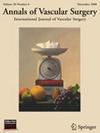Prediction of Chronic Limb Threatening Ischemia by Clinical Data: The PREDICCMI Study
IF 1.6
4区 医学
Q3 PERIPHERAL VASCULAR DISEASE
引用次数: 0
Abstract
Background
The main objective was to develop a clinical model to predict critical lower limb ischemia (CLI). Secondary objectives were to assess the reproducibility of clinical data and to create a predictive score for major amputation.
Methods
Prediction de l'ischémie critique des membres inférieurs was a French multicenter prospective observational study that included patients suspected of chronic limb threatening ischemia (CLTI). The first end point was hemodynamic confirmation of CLI according to the European consensus and Inter-Society Consensus for the Management of Peripheral Arterial Disease (TASC) II definitions. We created models from clinical data to predict CLTI and major amputation or vascular death at 1 year based on CLI classifications and clinical and hemodynamic data.
Results
Five hundred seventy-four patients were included. After a median follow-up of 22.3 months (Q1-Q3 10.8–34.7), 243 patients (42%) had died and 96 patients (16%) had undergone at least one major amputation. The clinical model poorly predicted objectively confirmed CLI (c index 0.610 [0.560–0.630]). However, a combination of clinical data and systolic toe pressure predicted the risk of major amputation (area under the curve 0.710 [0.647–0.760]).
Conclusion
Classical classifications of CLI are not adequately predicted by clinical parameters. While purely clinical models also poorly predict vascular outcome, a model including clinical data and systolic toe pressure seems to predict major amputation or vascular death satisfactory.
用临床数据预测慢性肢体威胁缺血:PREDICCMI研究。
目的:主要目的是建立一个临床模型来预测严重下肢缺血(CLI)。次要目的是评估临床数据的可重复性,并建立主要截肢的预测评分。方法:PREDICCMI是一项法国多中心前瞻性观察性研究,纳入疑似慢性肢体威胁性缺血(CLTI)的患者。第一个终点是根据欧洲共识和TASC II定义的CLI的血流动力学确认。我们根据临床数据创建模型,根据CLI分类、临床和血流动力学数据预测CLTI和主要截肢或一年后血管死亡。结果:纳入574例患者。中位随访22.3个月(Q1-Q3 10.8-34.7)后,243例患者(42%)死亡,96例患者(16%)至少进行了一次主要截肢。CLI的分类和临床模型对客观证实的CLI预测较差(c指数0.61[0.56-0.63])。然而,结合临床数据和脚趾收缩压预测大截肢的风险[AUC 0.710[0.647-0.760]。结论:临床参数不能很好地预测CLI的经典分类。虽然纯临床模型对血管预后的预测也很差,但包括临床数据和脚趾收缩压的模型似乎能令人满意地预测主要截肢或血管性死亡。
本文章由计算机程序翻译,如有差异,请以英文原文为准。
求助全文
约1分钟内获得全文
求助全文
来源期刊
CiteScore
3.00
自引率
13.30%
发文量
603
审稿时长
50 days
期刊介绍:
Annals of Vascular Surgery, published eight times a year, invites original manuscripts reporting clinical and experimental work in vascular surgery for peer review. Articles may be submitted for the following sections of the journal:
Clinical Research (reports of clinical series, new drug or medical device trials)
Basic Science Research (new investigations, experimental work)
Case Reports (reports on a limited series of patients)
General Reviews (scholarly review of the existing literature on a relevant topic)
Developments in Endovascular and Endoscopic Surgery
Selected Techniques (technical maneuvers)
Historical Notes (interesting vignettes from the early days of vascular surgery)
Editorials/Correspondence

 求助内容:
求助内容: 应助结果提醒方式:
应助结果提醒方式:


